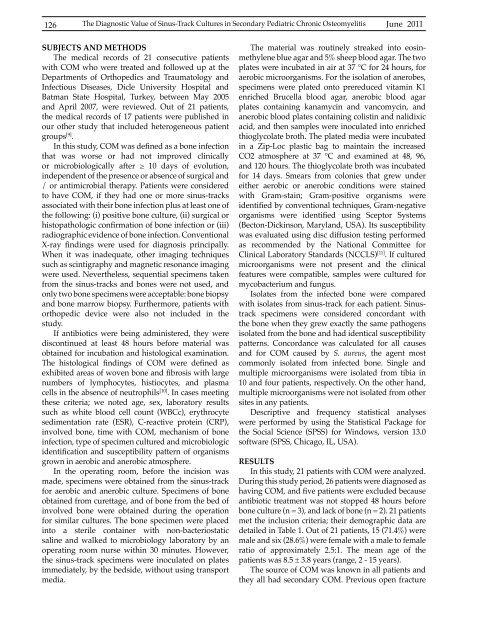Vol 43 # 2 June 2011 - Kma.org.kw
Vol 43 # 2 June 2011 - Kma.org.kw
Vol 43 # 2 June 2011 - Kma.org.kw
Create successful ePaper yourself
Turn your PDF publications into a flip-book with our unique Google optimized e-Paper software.
126<br />
The Diagnostic Value of Sinus-Track Cultures in Secondary Pediatric Chronic Osteomyelitis<br />
<strong>June</strong> <strong>2011</strong><br />
SUBJECTS AND METHODS<br />
The medical records of 21 consecutive patients<br />
with COM who were treated and followed up at the<br />
Departments of Orthopedics and Traumatology and<br />
Infectious Diseases, Dicle University Hospital and<br />
Batman State Hospital, Turkey, between May 2005<br />
and April 2007, were reviewed. Out of 21 patients,<br />
the medical records of 17 patients were published in<br />
our other study that included heterogeneous patient<br />
groups [9] .<br />
In this study, COM was defined as a bone infection<br />
that was worse or had not improved clinically<br />
or microbiologically after ≥ 10 days of evolution,<br />
independent of the presence or absence of surgical and<br />
/ or antimicrobial therapy. Patients were considered<br />
to have COM, if they had one or more sinus-tracks<br />
associated with their bone infection plus at least one of<br />
the following: (i) positive bone culture, (ii) surgical or<br />
histopathologic confirmation of bone infection or (iii)<br />
radiographic evidence of bone infection. Conventional<br />
X-ray findings were used for diagnosis principally.<br />
When it was inadequate, other imaging techniques<br />
such as scintigraphy and magnetic resonance imaging<br />
were used. Nevertheless, sequential specimens taken<br />
from the sinus-tracks and bones were not used, and<br />
only two bone specimens were acceptable: bone biopsy<br />
and bone marrow biopsy. Furthermore, patients with<br />
orthopedic device were also not included in the<br />
study.<br />
If antibiotics were being administered, they were<br />
discontinued at least 48 hours before material was<br />
obtained for incubation and histological examination.<br />
The histological findings of COM were defined as<br />
exhibited areas of woven bone and fibrosis with large<br />
numbers of lymphocytes, histiocytes, and plasma<br />
cells in the absence of neutrophils [10] . In cases meeting<br />
these criteria; we noted age, sex, laboratory results<br />
such as white blood cell count (WBCc), erythrocyte<br />
sedimentation rate (ESR), C-reactive protein (CRP),<br />
involved bone, time with COM, mechanism of bone<br />
infection, type of specimen cultured and microbiologic<br />
identification and susceptibility pattern of <strong>org</strong>anisms<br />
grown in aerobic and anerobic atmosphere.<br />
In the operating room, before the incision was<br />
made, specimens were obtained from the sinus-track<br />
for aerobic and anerobic culture. Specimens of bone<br />
obtained from curettage, and of bone from the bed of<br />
involved bone were obtained during the operation<br />
for similar cultures. The bone specimen were placed<br />
into a sterile container with non-bacteriostatic<br />
saline and walked to microbiology laboratory by an<br />
operating room nurse within 30 minutes. However,<br />
the sinus-track specimens were inoculated on plates<br />
immediately, by the bedside, without using transport<br />
media.<br />
The material was routinely streaked into eosinmethylene<br />
blue agar and 5% sheep blood agar. The two<br />
plates were incubated in air at 37 °C for 24 hours, for<br />
aerobic micro<strong>org</strong>anisms. For the isolation of anerobes,<br />
specimens were plated onto prereduced vitamin K1<br />
enriched Brucella blood agar, anerobic blood agar<br />
plates containing kanamycin and vancomycin, and<br />
anerobic blood plates containing colistin and nalidixic<br />
acid, and then samples were inoculated into enriched<br />
thioglycolate broth. The plated media were incubated<br />
in a Zip-Loc plastic bag to maintain the increased<br />
CO2 atmosphere at 37 °C and examined at 48, 96,<br />
and 120 hours. The thioglycolate broth was incubated<br />
for 14 days. Smears from colonies that grew under<br />
either aerobic or anerobic conditions were stained<br />
with Gram-stain; Gram-positive <strong>org</strong>anisms were<br />
identified by conventional techniques, Gram-negative<br />
<strong>org</strong>anisms were identified using Sceptor Systems<br />
(Becton-Dickinson, Maryland, USA). Its susceptibility<br />
was evaluated using disc diffusion testing performed<br />
as recommended by the National Committee for<br />
Clinical Laboratory Standards (NCCLS) [11] . If cultured<br />
micro<strong>org</strong>anisms were not present and the clinical<br />
features were compatible, samples were cultured for<br />
mycobacterium and fungus.<br />
Isolates from the infected bone were compared<br />
with isolates from sinus-track for each patient. Sinustrack<br />
specimens were considered concordant with<br />
the bone when they grew exactly the same pathogens<br />
isolated from the bone and had identical susceptibility<br />
patterns. Concordance was calculated for all causes<br />
and for COM caused by S. aureus, the agent most<br />
commonly isolated from infected bone. Single and<br />
multiple micro<strong>org</strong>anisms were isolated from tibia in<br />
10 and four patients, respectively. On the other hand,<br />
multiple micro<strong>org</strong>anisms were not isolated from other<br />
sites in any patients.<br />
Descriptive and frequency statistical analyses<br />
were performed by using the Statistical Package for<br />
the Social Science (SPSS) for Windows, version 13.0<br />
software (SPSS, Chicago, IL, USA).<br />
RESULTS<br />
In this study, 21 patients with COM were analyzed.<br />
During this study period, 26 patients were diagnosed as<br />
having COM, and five patients were excluded because<br />
antibiotic treatment was not stopped 48 hours before<br />
bone culture (n = 3), and lack of bone (n = 2). 21 patients<br />
met the inclusion criteria; their demographic data are<br />
detailed in Table 1. Out of 21 patients, 15 (71.4%) were<br />
male and six (28.6%) were female with a male to female<br />
ratio of approximately 2.5:1. The mean age of the<br />
patients was 8.5 ± 3.8 years (range, 2 - 15 years).<br />
The source of COM was known in all patients and<br />
they all had secondary COM. Previous open fracture
















